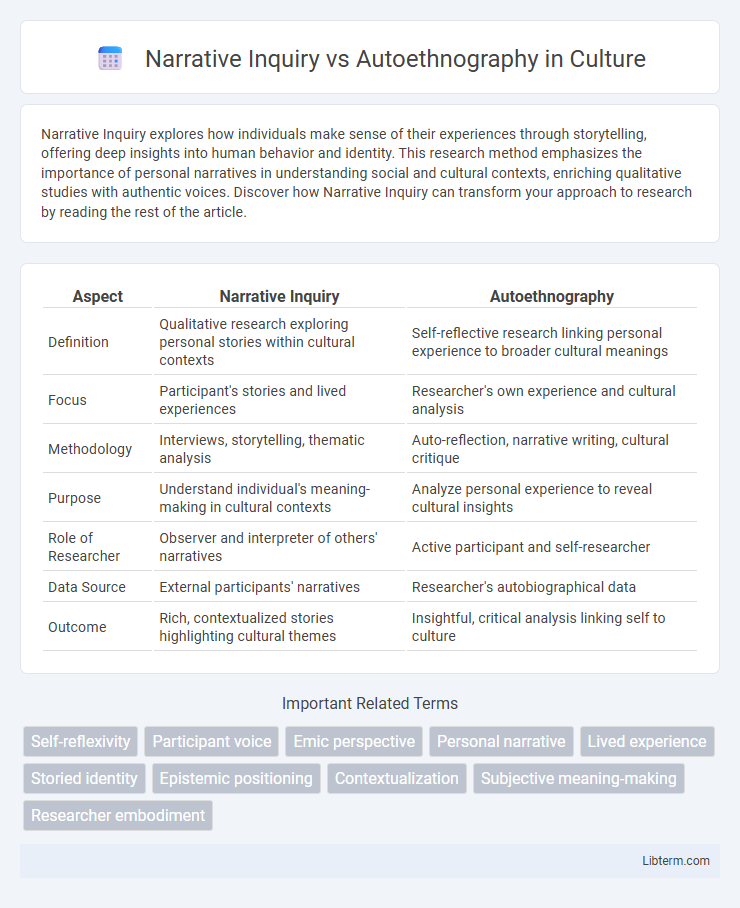Narrative Inquiry explores how individuals make sense of their experiences through storytelling, offering deep insights into human behavior and identity. This research method emphasizes the importance of personal narratives in understanding social and cultural contexts, enriching qualitative studies with authentic voices. Discover how Narrative Inquiry can transform your approach to research by reading the rest of the article.
Table of Comparison
| Aspect | Narrative Inquiry | Autoethnography |
|---|---|---|
| Definition | Qualitative research exploring personal stories within cultural contexts | Self-reflective research linking personal experience to broader cultural meanings |
| Focus | Participant's stories and lived experiences | Researcher's own experience and cultural analysis |
| Methodology | Interviews, storytelling, thematic analysis | Auto-reflection, narrative writing, cultural critique |
| Purpose | Understand individual's meaning-making in cultural contexts | Analyze personal experience to reveal cultural insights |
| Role of Researcher | Observer and interpreter of others' narratives | Active participant and self-researcher |
| Data Source | External participants' narratives | Researcher's autobiographical data |
| Outcome | Rich, contextualized stories highlighting cultural themes | Insightful, critical analysis linking self to culture |
Introduction to Qualitative Research Approaches
Narrative inquiry and autoethnography are qualitative research approaches that explore lived experiences through storytelling and personal reflection, respectively. Narrative inquiry emphasizes the co-construction of meaning between researcher and participant, focusing on the chronological sequence of events and their social context. Autoethnography combines autobiographical narrative with cultural analysis, allowing researchers to critically examine personal experiences within broader societal frameworks.
Defining Narrative Inquiry
Narrative Inquiry is a qualitative research method that explores individuals' lived experiences through storytelling, emphasizing the meaning-making processes in personal and social contexts. It involves collecting and analyzing narratives to understand how people construct and interpret their identities and realities over time. This approach prioritizes the co-creation of knowledge between researcher and participant, offering rich, in-depth insights into human experiences.
Understanding Autoethnography
Autoethnography is a qualitative research method that combines autobiography and ethnography to explore personal experiences within a broader cultural context. It emphasizes self-reflection and self-narration, allowing researchers to connect their individual stories to social phenomena and cultural meanings. Unlike narrative inquiry, which focuses primarily on storytelling and the structure of narratives, autoethnography prioritizes critical analysis of the researcher's own lived experiences to reveal insights about identity, culture, and power dynamics.
Core Philosophical Foundations
Narrative inquiry is grounded in the constructivist paradigm, emphasizing how individuals make sense of experiences through storytelling within social contexts. Autoethnography, rooted in postmodernism and critical theory, intersects personal narrative with cultural critique, highlighting reflexivity and subjectivity. Both methodologies prioritize lived experience but differ in the balance between individual meaning-making in narrative inquiry and the socio-political self-examination central to autoethnography.
Methodological Differences
Narrative Inquiry emphasizes collecting and analyzing stories to understand individual experiences within social contexts, using interviews and field notes as primary data sources. Autoethnography involves the researcher's self-reflection and autobiographical writing to connect personal experiences with broader cultural phenomena, prioritizing introspective analysis. The key methodological difference lies in Narrative Inquiry's focus on others' narratives and social interaction, whereas Autoethnography centers on the researcher's personal perspective and cultural self-examination.
Data Collection and Analysis Techniques
Narrative inquiry primarily collects data through participant storytelling, interviews, and personal narratives, emphasizing the chronological and thematic organization of experiences to uncover meaning. Autoethnography relies on self-reflective writing and introspective examination of the researcher's own experiences, using memoir, personal journals, and artifacts as data sources. Analysis in narrative inquiry involves interpreting stories to identify patterns and cultural insights, while autoethnography employs critical self-analysis to connect personal experiences with broader social and cultural contexts.
Researcher’s Role and Reflexivity
Narrative inquiry positions the researcher as a co-constructor of meaning, emphasizing the relational and contextual nature of stories gathered from participants, requiring deep reflexivity about power dynamics and interpretation. Autoethnography centers the researcher's personal experience as a primary data source, demanding intense reflexivity on the researcher's identity, emotions, and cultural positioning. Both methodologies prioritize reflexive practice but differ in the balance between external narratives and internal self-exploration in the research process.
Ethical Considerations Compared
Narrative inquiry emphasizes participant consent and confidentiality, prioritizing the ethical responsibility to represent stories accurately and respectfully within contextual boundaries. Autoethnography involves self-reflection and personal experience, raising unique ethical concerns about vulnerability, bias, and the impact of exposing one's private life to public scrutiny. Both methodologies require careful navigation of ethical standards to balance authenticity with respect for the individuals and communities involved.
Applications in Various Disciplines
Narrative inquiry is widely applied in education, healthcare, and social sciences to explore individuals' lived experiences and contextualize meaning within personal stories. Autoethnography, emphasizing self-reflection and cultural analysis, finds strong applications in anthropology, cultural studies, and psychology to examine identity and social norms from an insider perspective. Both methodologies enhance qualitative research by providing rich, detailed insights into human behavior and cultural phenomena across diverse academic fields.
Choosing the Right Approach for Your Study
Selecting between Narrative Inquiry and Autoethnography hinges on the research focus: Narrative Inquiry emphasizes collecting and interpreting others' stories to understand personal experiences within broader social contexts, while Autoethnography centers on the researcher's self-reflection to connect personal experience with cultural analysis. Researchers aiming to explore individual or collective experiences through external perspectives should opt for Narrative Inquiry, whereas those seeking in-depth examination of their own lived experiences and cultural identity benefit from Autoethnography. Understanding the intended depth of self-involvement and analytic focus is critical for guiding the methodological choice aligned with study aims.
Narrative Inquiry Infographic

 libterm.com
libterm.com